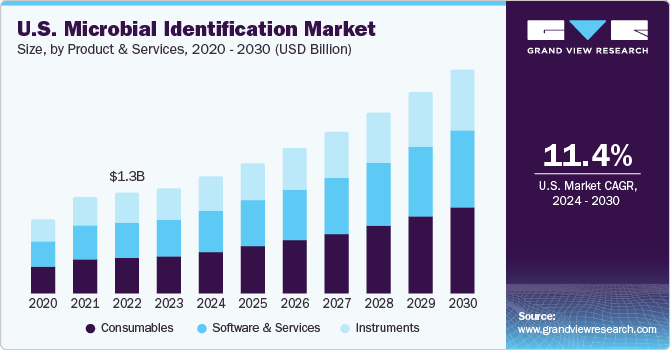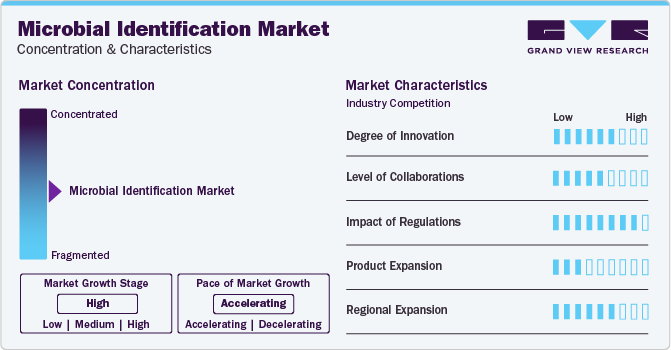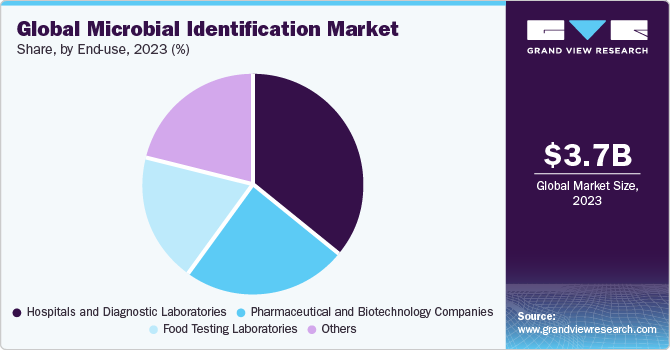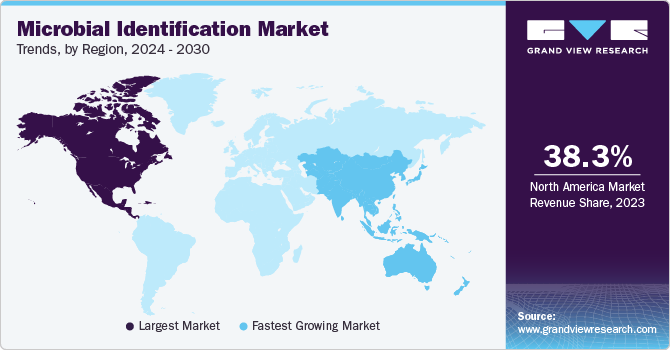- Home
- »
- Biotechnology
- »
-
Microbial Identification Market Size And Share Report, 2030GVR Report cover
![Microbial Identification Market Size, Share & Trends Report]()
Microbial Identification Market Size, Share & Trends Analysis Report By Product & Services, By Technology (Mass Spectrometry, PCR), By Method, By Application, By End-use, By Region, And Segment Forecasts, 2024 - 2030
- Report ID: GVR-4-68040-192-4
- Number of Report Pages: 130
- Format: PDF, Horizon Databook
- Historical Range: 2018 - 2023
- Forecast Period: 2024 - 2030
- Industry: Healthcare
Microbial Identification Market Size & Trends
The global microbial identification market size was estimated at USD 3.66 billion in 2023 and is expected to grow at a compound annual growth rate (CAGR) of 11.8% from 2024 to 2030. Rising prevalence of infectious diseases, technological advancements, growing R&D activities, and increasing government investments in biotechnology & life science sector are few of the factors which are anticipated to boost the market for the microbial identification. Moreover, the rising concern and awareness of food safety and environmental monitoring is projected to further drive the growth of the market from 2024 to 2030.

The market for microbial identification experienced a significant drop as a result of the COVID-19 pandemic. This was primarily due to a shortage of laboratory reagents for microbial identification and the temporary closure of diagnostic centers and hospitals. For instance, according to an article published in October 2021 on PubMed highlighted the reduced availability of high-quality laboratory reagents and consumables for bacteriology and antimicrobial susceptibility testing. Moreover, it also affected the maintenance and servicing of laboratory equipment, with more prominent impacts in regions of MEA. However, the market is expected to witness exponential growth in the coming years. This growth is attributed to the increasing concerns related to food contamination and a growing upsurge in government funding assigned to microbial identification testing.
Increasing investments and funding in microbial identification ensuring effective and speedy identification of bacteria causing infection thus, anticipated to drive the market over the forecast period. For instance, according to Welsh Government, in November 2021, an investment of over £1.2 million (USD 1.27 million) has planned to acquire six advanced microbiology equipment units capable of rapidly identifying bacteria in a matter of minutes, significantly reducing the risk of sepsis associated with delayed identification. Thus, these investments are anticipated to fuel the growth of the market over the forecast period.
The increasing number of infectious diseases is further expected to boost the market for microbial identification over the forecast period. For instance, in May 2023, WHO, in collaboration with its partners, initiated a worldwide network aimed at safeguarding individuals against infectious disease risks by harnessing the capabilities of pathogen genomics. The International Pathogen Surveillance Network (IPSN) would serve as a framework connecting nations and geographic regions, thus, enhancing the infrastructure for sample collection and analysis, leveraging the data to inform public health decisions, and facilitating the broader dissemination of this valuable information. Therefore, impelling the growth of identification of microbial genome, thereby propelling the growth of the market.
Market Concentration & Characteristics
Market growth stage is high, and pace of the market growth is accelerating. The prevalence of infectious diseases continues to be a global concern. As new pathogens emerge and existing ones evolve, there is a growing need for accurate and rapid microbial identification to facilitate timely and effective treatment.

The market is also characterized by a high level of merger and acquisition (M&A) activity undertaken by the leading players. This is due to several factors, the rising focus on increasing the company’s products & services portfolio, the need to consolidate in a rapidly growing market, and the increasing strategic importance of microbiology. Several companies are undertaking this strategy to strengthen their portfolio. For instance, in June 2022, bioMérieux completed the acquisition of Specific Diagnostics for about USD 416.8 million, constituting 3.2 % of the French diagnostic company's market capitalization.
Stringent regulations related to the quality and safety of pharmaceuticals, medical devices, and food products have stimulated the adoption of microbial identification methods. Government initiatives to control the spread of infectious diseases also play a role in driving market growth.
Several companies are expanding their microbiology-based products. Thus, the product expansion in this industry is significant. For instance, in May 2023, Cherwell, announced their plan to introduce a novel Biofluorescent Particle Counter (BFPC) to the UK and Ireland during the Cleanroom Technology Conference 2023.
Product & Services Insights
The consumables segment held the largest market share of 36.51% in 2023. Consumables in the microbial identification industry include items like culture media, reagents, and test kits which are required to be frequently replenished. Laboratories and research facilities require a constant supply of these consumables to perform microbial identification tests. This consistent need for replacement generates a steady stream of revenue for manufacturers and suppliers. For instance, in August 2023, Lovibond’s test kits are tailored for industrial applications. Due to the rising importance of water resources and the legal mandates governing their responsible management, Lovibond aims to offer complete solutions which can effectively address specific needs and facilitate precise, effortless water analyses. These launches are anticipated to fuel the growth of the segment.
The software & services segment is anticipated to grow at the highest CAGR from 2024 to 2030. Software solutions have become increasingly important in the field of microbial identification. Advanced data analytics, including machine learning and artificial intelligence, are being used to analyze and interpret the data generated during microbial identification processes. This can lead to more accurate and efficient results, which are critical in various applications, such as clinical diagnostics, food safety, and environmental monitoring. Thus, anticipated to fuel the growth of the segment for the microbial identification industry over the forecast period.
Technology Insights
The PCR segment held the largest market share in 2023. Owing to the high precision, speed, and versatility in detecting and identifying microorganisms. PCR enables the amplification of specific DNA sequences, making it highly sensitive and capable of detecting even trace amounts of microbial DNA. Moreover, it is widely used in clinical diagnostics, research laboratories, and various industries for microbial identification due of its ability to quickly and accurately identify pathogens, playing an important role in disease diagnosis, food safety, and environmental monitoring. In August 2022, Bruker Corporation announced the advancements to its dominant MALDI Biotyper (MBT) platform and introduced novel multiplex PCR infectious disease assays, leveraging its exclusive LiquidArray technology. Thereby propelling the growth of the segment.
The next generation sequencing segment is anticipated to grow at the highest CAGR of 14.72% from 2024 to 2030. NGS technologies enable the sequencing of entire genomes, allowing for highly accurate species identification, even at the strain level. This level of granularity is acute in various applications, including clinical diagnostics, epidemiology, and research. In January 2023, Charles River hasintroduced Accugenix Next Gen Sequencing for Bacterial Identification and Fungal Identification, a novel sequencing solution integrated into the Accugenix portfolio of microbial testing services. Thus, anticipated to fuel the growth of the segment for the microbial identification industry over the forecast period.
Method Insights
The genotypic segment held the largest market share of 41.83% in 2023 and is anticipated to grow at the highest CAGR from 2024 to 2030. Genotypic methods, comprising of DNA sequencing and DNA fingerprinting techniques, offer high accuracy and specificity. They can identify microorganisms at the genetic level, which often provides more precise results compared to phenotypic methods. Moreover, genotypic methods are used in various applications, including clinical diagnostics, epidemiological studies, environmental assessments, and microbial diversity research. This wide range of applications has contributed to fuel the growth of the segment in the market.
Moreover, the growing adoption of precision medicine, which involves tailoring medical treatments to the individual characteristics of each patient, has increased the demand for genotypic identification. Understanding the genetic makeup of microorganisms is crucial for personalized treatment plans. Thus, anticipated to fuel the growth of the segment for the market for microbial identification over the forecast period.
Application Insights
The clinical diagnostics segment held the largest market share in 2023. Due to the rising prevalence of infectious diseases the segment is anticipated to fuel the growth of the segment. Moreover, the advancements in molecular biology techniques, such as PCR and next-generation sequencing, is projected to significantly improve the speed and accuracy of microbial identification in clinical settings. These advancements and rising prevalence of infectious disease are anticipated to impel the growth of clinical diagnostics segments for better efficient and accessible. Thereby anticipating the growth of the market from 2024 to 2030.
The pharmaceuticals segment is anticipated to grow at the highest CAGR of 14.83% from 2024 to 2030. The pharmaceutical industry is directly involved in the development of treatments and vaccines for emerging infectious diseases. Accurate and rapid microbial identification is essential during epidemic outbreaks, which has been a significant driver for the pharmaceutical sector. Thus, the rising prevalence of infection diseases is anticipated to fuel the growth of the segment for the microbial identification market over the forecast period.
End-use Insights
The hospitals & diagnostic laboratories segment held the largest market share of 35.82% in 2023. Owing to the high patient volume and a diverse range of clinical scenarios, the demand for microbial identification services is consistent, thereby anticipated to fuel the growth of the segment. Moreover, the necessity for rapid, accurate identification of pathogens further solidifies the market share of hospitals and diagnostic laboratories in the microbial identification industry.

The pharmaceutical & biotechnology companies’ segment is anticipated to grow at the highest CAGR over the forecast period. The pharmaceutical & biotechnology sectors play an important role in the development of treatments and vaccines for emerging infectious diseases. Rapid and precise microbial identification is essential in the early detection and containment of outbreaks, such as the COVID-19 pandemic. Hence, the anticipated to significantly drive the growth of the segment from 2024-2030.
Regional Insights
North America microbial identification market accounted for the largest market share of 38.25% in 2023. This is attributed to the increasing prevalence of infectious diseases, presence of key market players, and well-established healthcare infrastructure. In January 2022, BD has secured FDA 510(k) clearance for the BD Kiestra IdentifA system, an automated platform specifically engineered to streamline the microbiology bacterial identification testing sample preparation process.

Moreover, due to the rising concerns regarding food safety by government and regional authorities, the use of microbial identification techniques to identify and trace microbes in food products. For instance, according to a June 2022 article in PubMed, various organizations at the federal, state, and local levels play distinct roles in formulating, executing, and upholding food safety regulations in the U.S. Hence, ensuring effective collaboration among all these bodies is essential to ensure food safety. These factors are thus anticipated to fuel the growth of the market in the region.
U.S. Microbial Identification Market Trends
The U.S. microbial identification market is expected to grow over the forecast period due to presence of large number of market players present in U.S. which are undergoing various strategic initiatives such as collaborations and partnerships.
Europe microbial identification market was identified as a lucrative region in this industry. This is attributed to strong government support and advancements in research infrastructure.
UK Microbial Identification Market Trends
The UK microbial identification market is expected to grow over the forecast period due to increasing prevalence of infectious diseases and a growing emphasis on diagnostic accuracy, the demand for clinical microbiology products and services has increased.
France Microbial Identification Market Trends
France microbial identification market is expected to grow over the forecast period due to the presence of key manufacturers such as bioMérieux SA and the growth in strategic initiatives undertaken by them.
Germany Microbial Identification Market Trends
Germany microbial identification market is expected to grow over the forecast period due to presence of a substantial number of providers offering messenger RNA therapeutics and initiatives undertaken to expand the scope of these tools.
Asia Pacific is anticipated to witness significant growth in the market from 2024 to 2030. The increasing prevalence of infectious diseases and economic growth of countries like India and China has led to the increasing investments in pharmaceutical & biotechnology companies as well as healthcare and other industry. Thereby driving the demand for microbial identification solution, thus fueling the growth of segment.
China Microbial Identification Market Trends
China microbial identification market is expected to grow over the forecast period driven by factors such as increasing awareness of infectious diseases, rising healthcare expenditure, and advancements in diagnostic technologies.
India Microbial Identification Market Trends
India microbial identification market is expected to grow over the forecast period due to growing investments by private and foreign entities that can help provide effective tests at lower costs. For instance, in June 2020, Combating Antibiotic-Resistant Bacteria Biopharmaceutical Accelerator (CARB-X) awarded an investment grant to Module Innovations, an India-based company.
Japan Microbial Identification Market Trends
Japan microbial identification market is expected to grow over the forecast period due to growing strategic initiatives, such as collaborations, mergers & acquisitions, and product launches, to increase their market share. In August 2022, the government of Japan collaborated with the United Nations Office for Project Services to support Indonesia by delivering essential equipment, personal protective equipment, and medical supplies.
Key Microbial Identification Company Insights
Some of the key players operating in the market include Charles River Laboratories, Thermo Fisher Scientific, Inc, Merck KGaA, bioMérieux SA, and QIAGEN.
Key Microbial Identification Companies:
The following are the leading companies in the microbial identification market. These companies collectively hold the largest market share and dictate industry trends. Financials, strategy maps & products of these microbial identification companies are analyzed to map the supply network.
- bioMérieux SA
- Becton, Dickinson and Company
- ThermoFisher Scientific Inc.
- Bruker Corporation
- Danaher Corporation
- Qiagen N.V.
- Charles River Laboratories
- Wickham Micro Limited
- VWR International LLC. (Avantor Inc.)
- Comp10
- Shimadzu Corporation
- Merck KGaA
- Eurofins Scientific SE
- Biolog Inc
Recent Developments
-
In November 2023, QIAGEN has introduced a comprehensive Sample to Insight workflow tailored for microbiome research which is anticipated to accelerate research workflow which include whole genome metagenomics library preparation, DNA extraction kits, and bioinformatics analysis.
-
In August 2023, Ampath announced a reference laboratory in Gurgaon, marking a significant milestone in its expansion strategy. This facility provides a wide range of diagnostic tests encompassing clinical biochemistry, haematology, flow cytometry, clinical pathology, serology, immunology, microbiology, cytology, histopathology, immunohistochemistry, molecular diagnosis, NGS, cytogenetics, and more.
-
In July 2023, Eurofins Scientific announced the expansion of microbial laboratory in Texas, there by boosting the growth of microbial identification market over the forecast period.
-
In May 2023, Merck KGaA invested around €35 million (USD 38.35 million) for biosafety testing at its facilities in Glasgow and Stirling, Scotland. This investment aims to enhance biosafety testing, a crucial stage in the drug development and manufacturing process, ensuring the safety, efficacy, and regulatory compliance of pharmaceuticals.
-
In May 2023, Charles River announces the launch of Next Generation Sequencing Services, Accugenix NGS focusing on bacterial and fungal identification. Which is expected to offer primary information to pharmaceutical manufacturers concerning microbial control.
-
In April 2023, Bruker Corporation announced a cutting-edge fungi IVD and mycobacteria solutions for Novel LiquidArray and MALDI Biotyper gastrointestinal syndromic panel.
-
In January 2023, BD has introduced its third-generation total lab automation system, allowing laboratories to create a customized and flexible configuration for total lab automation by connecting various BD Kiestra modules.
Microbial Identification Market Report Scope
Report Attribute
Details
Market size value in 2024
USD 4.07 billion
Revenue forecast in 2030
USD 7.95 billion
Growth rate
CAGR of 11.8% from 2024 to 2030
Actual data
2018 - 2023
Forecast period
2024 - 2030
Quantitative units
Revenue in USD million/billion, and CAGR from 2024 to 2030
Report coverage
Revenue forecast, company ranking, competitive landscape, growth factors, and trends
Segments covered
Product & services, technology, method, application, end-use, region
Regional scope
North America; Europe; Asia Pacific; Latin America; MEA
Country scope
U.S.; Canada; Germany; UK; France; Italy; Spain; Denmark; Sweden; Norway; China; Japan; India; South Korea; Australia; Thailand; Brazil; Mexico, Argentina; South Africa; Saudi Arabia, UAE; Kuwait
Key companies profiled
bioMérieux SA; Becton; Dickinson and Company; Thermo Fisher Scientific Inc.; Bruker Corporation; Danaher Corporation; Qiagen N.V.; Charles River; Wickham Micro Limited; VWR International LLC. (Avantor Inc.); Shimadzu Corporation; Merck KGaA; Eurofins Scientific SE; Biolog Inc.
Customization scope
Free report customization (equivalent up to 8 analysts working days) with purchase. Addition or alteration to country, regional & segment scope.
Pricing and purchase options
Avail customized purchase options to meet your exact research needs. Explore purchase options
Global Microbial Identification Market Report Segmentation
This report forecasts revenue growth at global, regional, and country levels and provides an analysis of the latest industry trends in each of the sub-segments from 2018 to 2030. For this study, Grand View Research has segmented the global microbial identification market report based on product & services, technology, method, application, end-use, and region.
-
Product & Services Outlook (Revenue, USD Million, 2018 - 2030)
-
Instruments
-
Mass Spectrometers
-
PCR Systems
-
Microarrays
-
Others
-
-
Consumables
-
Reagents & Kits
-
Plates & Media
-
-
Software & Services
-
Identification Services
-
Culture Collection Services
-
Assay Validation Services
-
-
-
Technology Outlook (Revenue, USD Million, 2018 - 2030)
-
Mass Spectrometry
-
PCR
-
Microarrays
-
Next Generation Sequencing
-
Others
-
-
Method Outlook (Revenue, USD Million, 2018 - 2030)
-
Phenotypic Methods
-
Genotypic Methods
-
Proteotypic Methods
-
-
Application Outlook (Revenue, USD Million, 2018 - 2030)
-
Clinical Diagnostics
-
Pharmaceuticals
-
Food & Beverage Testing
-
Environmental Application
-
Others
-
-
End-use Outlook (Revenue, USD Million, 2018 – 2030)
-
Pharmaceutical and Biotechnology Companies
-
Hospitals and Diagnostic Laboratories
-
Food Testing Laboratories
-
Others
-
-
Regional Outlook (Revenue, USD Million, 2018 - 2030)
-
North America
-
U.S.
-
Canada
-
-
Europe
-
Germany
-
UK
-
France
-
Italy
-
Spain
-
Denmark
-
Sweden
-
Norway
-
-
Asia Pacific
-
China
-
Japan
-
India
-
South Korea
-
Australia
-
Thailand
-
-
Latin America
-
Brazil
-
Mexico
-
Argentina
-
-
Middle East & Africa
-
South Africa
-
Saudi Arabia
-
UAE
-
Kuwait
-
-
Frequently Asked Questions About This Report
b. The global microbial identification market size was estimated at USD 3.66 billion in 2023 and is expected to reach USD 4.07 billion in 2024.
b. The global microbial identification market is expected to grow at a compound annual growth rate of 11.80% from 2024 to 2030 to reach USD 7.95 billion by 2030.
b. North America dominated the global microbial identification market with a share of 38.2% in 2023. This is mainly attributed to the increasing prevalence of infectious diseases, presence of key market players, and well-established healthcare infrastructure.
b. Some key players operating in the microbial identification market include bioMérieux SA, Becton, Dickinson and Company, Thermo Fisher Scientific Inc., Bruker Corporation, Danaher Corporation, Qiagen N.V., Charles River, Wickham Micro Limited, VWR International LLC. (Avantor Inc.), Shimadzu Corporation, Merck KGaA, Eurofins Scientific SE, and Biolog Inc.
b. Key factors driving the market growth include the rising prevalence of infectious diseases and technological advancements in the quality control market space.
Share this report with your colleague or friend.
![gvr icn]()
NEED A CUSTOM REPORT?
We can customize every report - free of charge - including purchasing stand-alone sections or country-level reports, as well as offer affordable discounts for start-ups & universities. Contact us now
![Certified Icon]()
We are GDPR and CCPA compliant! Your transaction & personal information is safe and secure. For more details, please read our privacy policy.
We are committed towards customer satisfaction, and quality service.
"The quality of research they have done for us has been excellent."





